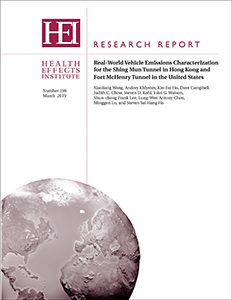You are here
Study examines real-world emissions characterization in two traffic tunnels
 HEI has published Research Report 199, Real-World Vehicle Emissions Characterization for the Shing Mun Tunnel in Hong Kong and Fort McHenry Tunnel in the United States, which describes a study led by Dr. Xiaoliang Wang at the Desert Research Institute in Reno, Nevada. Wang and his colleagues sought to evaluate how mobile-source emissions have changed over time by characterizing real-world emissions in two traffic tunnels that had been studied in the past: the Shing Mun Tunnel in Hong Kong and the Fort McHenry Tunnel in Baltimore, Maryland. They measured more than 300 pollutants and used the data to derive average pollutant-specific emission factors for the vehicle fleet in each tunnel. They then compared their results with previous studies in the same tunnels and elsewhere and found significant emissions reductions for most pollutants. In addition, they established VOC source profiles for volatile organic compounds and fine particulate matter (PM2.5). They also differentiated between tailpipe and non-tailpipe PM2.5. Finally, they evaluated the performance of mobile-source emission models used in the regulatory process by comparing the modeled emission factors to the emission factors measured in the tunnels.
HEI has published Research Report 199, Real-World Vehicle Emissions Characterization for the Shing Mun Tunnel in Hong Kong and Fort McHenry Tunnel in the United States, which describes a study led by Dr. Xiaoliang Wang at the Desert Research Institute in Reno, Nevada. Wang and his colleagues sought to evaluate how mobile-source emissions have changed over time by characterizing real-world emissions in two traffic tunnels that had been studied in the past: the Shing Mun Tunnel in Hong Kong and the Fort McHenry Tunnel in Baltimore, Maryland. They measured more than 300 pollutants and used the data to derive average pollutant-specific emission factors for the vehicle fleet in each tunnel. They then compared their results with previous studies in the same tunnels and elsewhere and found significant emissions reductions for most pollutants. In addition, they established VOC source profiles for volatile organic compounds and fine particulate matter (PM2.5). They also differentiated between tailpipe and non-tailpipe PM2.5. Finally, they evaluated the performance of mobile-source emission models used in the regulatory process by comparing the modeled emission factors to the emission factors measured in the tunnels.
| Attachment | Size |
|---|---|
| 332.52 KB |